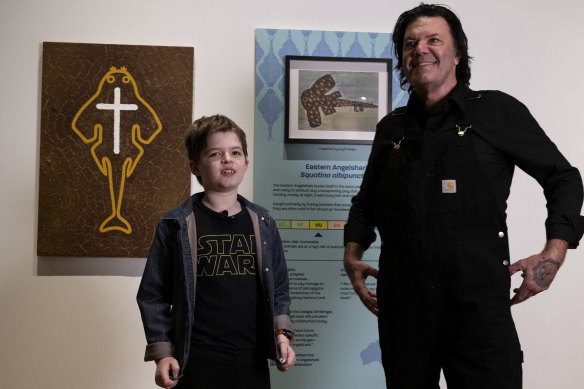This was published 7 months ago
How 11-year-old Leah’s art ended up in a museum, and inspiring Ken Done
By Julie Power
The lined lantern shark looks more like a tadpole than a shark. True to its name, it glows.
That description was enough to spark the imagination of Zara Pease. “I picked this little shark for its quirky appearance and ability to stand out,” she said of her artwork created using acrylic black paint and Posca pens.
The 13-year-old was one of 1500 children from across Australia who entered a contest to draw or paint sharks and rays to raise awareness of threatened species and the risk of overfishing – and how populations can recover if they’re protected.
The finalists were asked to depict one of 10 lesser-known rays or sharks, including many that are threatened or are being driven to extinction by industrialised fishing.
An established artist then created a work inspired by the children, and the results are on show at the Fantastical Sharks and Rays exhibition at the Australian Museum in Sydney.
Zara’s work inspired jewellery by Australian jewellery brand Sarah & Sebastian, whose creative director Sarah Munro said: “Sharks are the jewels of our sapphire oceans.”
Leah Djikic, 11, of Goulburn was inspired by this description: “Imagine if a shark and a ray had a baby that looked like a violin.”
Her art depicting a southern/eastern fiddler ray inspired Sydney painter Ken Done.
Overfishing threatened the survival of many species, scientists said at the exhibition launch.
Dr Leonardo Guida, a marine scientist with the Australian Marine Conservation Society, said new Australian species were being discovered, with 331 this year compared with 328 in 2021.
Undiscovered and undescribed species could become extinct without scientists ever documenting them, he said.
“The Australian [marine] species are as unique as a koala, and in just as much strife. They are not found anywhere else in the world, largely for the same reasons [as the koalas], because they’ve evolved in isolation,” he said.
“A lot of these species are found in really deep waters, so they’re typically out of sight, out of mind.
“We want to make sure our oceans are healthy because we are clearly at risk of losing species before we even get a chance to know them.”

Gryff Nolan, 9, with artist Blak Douglas and their eastern angelshark artworks.Credit: Louise Kennerley
Artist Blak Douglas, for example, was inspired by an artwork of an eastern angelshark by nine-year-old Gryff Nolan of Brisbane. The shark resembles an angel that has lost its wings.
Sydney artist Jennifer Turpin and Inara Wilson, 5, from Melbourne brought the whitefin swellshark to life.
The artist said she was captivated by the way that Inara had painted the swellshark surrounded by seaweed in its natural environment. It showed the young artist understood its importance as well.
Guida said the swellshark was unique to Australia. “It can still be legally caught, and risks ending up in our fish and chip shops, commonly sold as flake.”
Unlike other species, it was robust and, if caught accidentally, and thrown back, could often survive.
Oliver McIntyre, 7, chose the greeneye spurdog, a shark that lives more than a kilometre below the surface because it was the only species he didn’t know. “It sounded goofy,” he said.
Guida said the greeneye spurdog was an incredible animal, and more vulnerable than others because it has one of the longest pregnancies of any vertebrate animal in the world.
“It takes up to three years, and it will give birth to four to 10 pups. When you consider how long it lives, it maybe only has four to five chances of reproducing.”
Its flesh had also been found being sold as flake in a fish shop.
“When you look at where these species are, how vulnerable they are to overfishing, there is really an urgency to protect them,” Guida said.
Fantastical Sharks and Rays runs at the Australian Museum until December 8. It includes the works by the 10 winners, artists inspired by the children, and specimens of the creatures from the museum’s collection.
Get to the heart of what’s happening with climate change and the environment. Sign up for our fortnightly Environment newsletter.